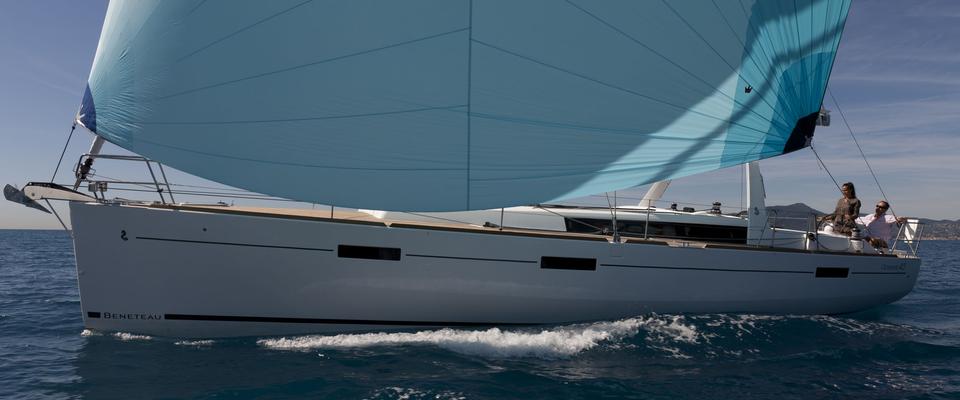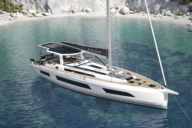A few summers ago I signed on to crew aboard the brand new Beneteau Oceanis 45 on the delivery leg between the Newport, RI boat show and the Norwalk, CT boat show. It’s a run of about 140 miles across Block Island Sound and down Long Island Sound, which we planned to do in a straight shot through the night. That sounded like fun and would be a great way to get to really test the new Berret-Racoupeau designed cruising sloop.
But Irene got in the way. She was a wicked fall hurricane that slammed into mid-Atlantic and New England coastlines and left in her wake a mass of waterborne debris. Everything from trees to refrigerators could be found floating in the waters along the coast, so we made the decision to make the delivery a two-day affair.
We set off from Newport in the early afternoon with the 54 horsepower Yanmar and three-bladed fixed prop shunting us along at 6.5 knots as we maintained a constant 2200 rpms—the “break in” revs for the new engine. There were five of us aboard, including me, the delivery skipper and his mate, and two prospective buyers who had flown in to Newport just to make this trip. Needless to say, we were overstaffed. But that was fine, as we all fit into the huge cockpit or around the saloon dinette table with room to spare.
The Oceanis 45 is the little sister to the new Oceanis 50 that debuted last year. The themes that made that boat so popular have been refined in the new 45-footer. The mainsheet runs to an arch at the forward end of the cockpit, so the cockpit is not obstructed by the sheet and tackle as you tack or jibe.
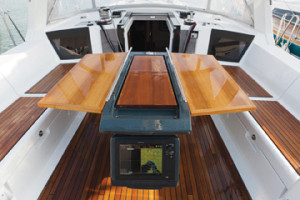 The 45 has an attractive cockpit table trimmed in teak, with a pod at its aft end for the chartplotter. Five of us ate comfortably around the table and we could have fit three more in a pinch.
The 45 has an attractive cockpit table trimmed in teak, with a pod at its aft end for the chartplotter. Five of us ate comfortably around the table and we could have fit three more in a pinch.
The 45 has a nearly full-beam folding transom that works as an aft bench when it is up and as a huge water-sports platform when lowered. It is large enough for swimming and sunning, using SCUBA gear or rigging a sailing dinghy. The ladder is demountable and is designed like a swimming pool ladder so it is really easy to climb.
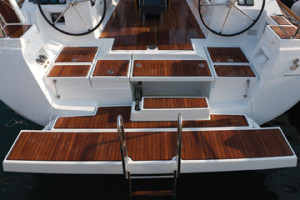 All of the working sheets and control lines lead aft to the cockpit and most run through conduits on the cabintop to winches on both sides of the companionway. As we motored out of Narragansett Bay, we rolled out the in-mast roller-furling mainsail and trimmed for motorsailing. The afternoon sea breeze had stalled, so we were forced to motor for a couple of hours as we rounded Point Judith and steamed along the coast to Fisher’s Island Sound. With the sail full, our speed bumped up nicely to 7 knots.
All of the working sheets and control lines lead aft to the cockpit and most run through conduits on the cabintop to winches on both sides of the companionway. As we motored out of Narragansett Bay, we rolled out the in-mast roller-furling mainsail and trimmed for motorsailing. The afternoon sea breeze had stalled, so we were forced to motor for a couple of hours as we rounded Point Judith and steamed along the coast to Fisher’s Island Sound. With the sail full, our speed bumped up nicely to 7 knots.
Finally, as the sun was getting low, the breeze kicked in and we were able to put the boat through her paces and sail the last 10 miles to our destination in Mystic, CT. Fisher’s Island Sound is a large, protected body of water with reefs and sand bars, so we tacked carefully to windward along the island shore. The 45 handled well under full main and genoa. The beamy hull, with the extra beam at the chine aft, stood up very nicely to the puffs and was happiest sailing very flat.
One of the benefits of the roller furling sails on both the main and the genoa is the ability for you to dial in just as much sail power as you need. With the new vertical batten, roller mainsails, or with a in-boom furling main, you can roll in just as much sail as you want to keep the helm balanced and the boat trimmed for optimum speed. If you are used to sailing narrow older designs that like to sail upwind at 15 degrees of heel or more, then the almost flat sailing angles of modern designs like the Oceanis 45 will be a pleasant adjustment.
Storage on deck is often an issue in boats with two aft cabins and a full width forward cabin. In the 45, lockers have been included under the cockpit sole aft, under the cockpit seats and in a huge locker forward of the forward cabin. This “garage” is deep and large enough for all of your fenders, docking lines, a couple of spinnakers, and possibly a couple of folding bikes.
The chain locker has the windlass built in under the lifting hatch cover so it is out of the way when sailing. The locker is large enough for 250 feet of chain and there is also room for a second rope-chain rode and a second anchor.
We sailed the 45 upwind for a while and found that she tacked easily inside 90 degrees and was capable of 7+ knots in 12 knots of breeze. Off the wind, as we headed toward Mystic, she slid along nicely at 7 to 8 knots and was easy to steer even through some strong puffs.
Like the Oceanis 50, the 45 feels like a big boat underfoot and has plenty of space on deck for a big sailing party. But, the boat sails well and is simple and easy to handle for a couple or even a singlehander.
ACCOMMODATIONS
The Oceanis 45 has two cabin variations. The boat we sailed had a large master cabin forward with its own head and two quarter cabins aft. You can also opt to have only one quarter cabin, which converts the port cabin into a huge sail and storage locker. The two-cabin layout will work well for owners who will be living aboard for long periods and may want to add a genset, extra tankage, and all of the sundry gear and equipment cruisers always collect along the way. The aft cabins are large by any standard. The berths are wide and long enough for standard-issue Americans and there is plenty of headroom. Quarter cabins can be dark and cavernous, but the 45’s designers solved this problem by adding large windows—with shades—facing aft into the cockpit and ample ventilation via the deck hatch and opening port.
The forward cabin has a queen-size double berth on the centerline so you can make the bed easily from the sides and climb in and out without trampling your bedmate. The storage and hanging lockers offer plenty of space for a couple’s clothing and stuff, and the large drawer under the berth will be a great home for linens, blankets and offseason clothing.
Both of the heads on the 45 have separate shower stalls that are partitioned with bi-fold acrylic doors. The forward head is slightly smaller than the aft head, but is still plenty large enough for all of its intended purposes. The after head will double as the wet locker for foul weather gear while underway since it is at the foot of the companionway ladder.
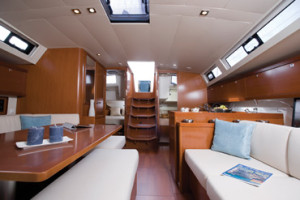 The saloon has the L-shaped galley to port, a bench settee to port and the eight-person dinette to starboard. At the foot of the companionway, the galley is well lit, well ventilated and has plenty of storage space for living aboard. There is a top-loading fridge-freezer and a side-loading fridge, so you will never run out of cool beverages and can carry a lot of perishables for the long haul. The double sinks are outboard, so they may not drain when hard on the starboard tack; but if they don’t drain, the skipper has probably got the main strapped in too tightly, which makes the boat heel more than it should!
The saloon has the L-shaped galley to port, a bench settee to port and the eight-person dinette to starboard. At the foot of the companionway, the galley is well lit, well ventilated and has plenty of storage space for living aboard. There is a top-loading fridge-freezer and a side-loading fridge, so you will never run out of cool beverages and can carry a lot of perishables for the long haul. The double sinks are outboard, so they may not drain when hard on the starboard tack; but if they don’t drain, the skipper has probably got the main strapped in too tightly, which makes the boat heel more than it should!
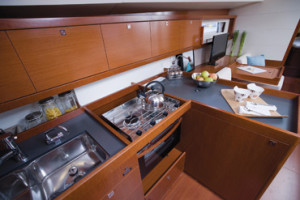 It is interesting that chart tables have gradually disappeared from modern cruising boats over the last decade. Now that most of us navigate with chartplotters in the cockpit, that means that we also have our paper charts, tide tables and cruising guides in the cockpit in fine weather. This makes sense. On the 45, the port settee is the nominal chart table and has been configured with a creative system of three folding seats that each convert into a table. So, you can have three side-by-side seats or you can flip up a table to create a chart table, or a serving table next to the galley, or a card table between two forward and aft seats. Radios, sat phones, instrument repeaters and other nav instruments can be mounted in the cabinet above the seats.
It is interesting that chart tables have gradually disappeared from modern cruising boats over the last decade. Now that most of us navigate with chartplotters in the cockpit, that means that we also have our paper charts, tide tables and cruising guides in the cockpit in fine weather. This makes sense. On the 45, the port settee is the nominal chart table and has been configured with a creative system of three folding seats that each convert into a table. So, you can have three side-by-side seats or you can flip up a table to create a chart table, or a serving table next to the galley, or a card table between two forward and aft seats. Radios, sat phones, instrument repeaters and other nav instruments can be mounted in the cabinet above the seats.
The fit and finish of the new Beneteau has been styled by Nauta Design with a very modern, somewhat angular look. The veneer on the boat we sailed was a teak-like wood called Alpi that has a uniform grain and very consistent color. The interior is warm and nods to tradition but is still very 2011.
Four of us slept on the boat that night—one in each of the separate cabins, and I on the bench in the dinette. This worked well and if anyone snored, no one complained, or possibly no one heard it.
BWS THOUGHTS
The new production boats coming in from Europe, where the companies are coming out with new models every year, are evolving quickly. The extremely wide transoms—and now the chines we see in the Oceanis 45 and other production boats—look massive next to a more traditional boat. The high topsides and low cabintops add to the visual mass of the boats, so they again look huge in comparison to traditional designs. Yet, form follows function. The new designs sail flatter and faster and are easier to sail than traditional boats, and the accommodations below are simply vaster and more comfortable.
Modern production techniques and economies of scale allow companies like Beneteau to buy materials, gear, spars and engineering at very competitive prices, which allows them to pass along savings to their owners. In our view, the value proposition of the new Oceanis 45 and other boats in this category has never been better. In the Oceanis 45, you really do get a lot of boat and a lot of ocean sailing capability for a very reasonable price.
by George Day
Beneteau Oceanis 45
LOA45’5”
LWL42’10”
Beam14’9”
Draft7’1”
Draft (shoal)5’9”
Displacement21,048 lbs.
Ballast6,191 lbs.
Ballast (opt)6,693 lbs.
Sail area1,130 sq, ft.
Fuel53 gals.
Water151 gals.
Engine54-hp. Yanmar
Design: Berret- Racoupeau
Styling: Nauta Design
Beneteau USA
Marion, SC
Phone: (843) 629-5300
Fax: (843) 629-5309
www.beneteauusa.com

